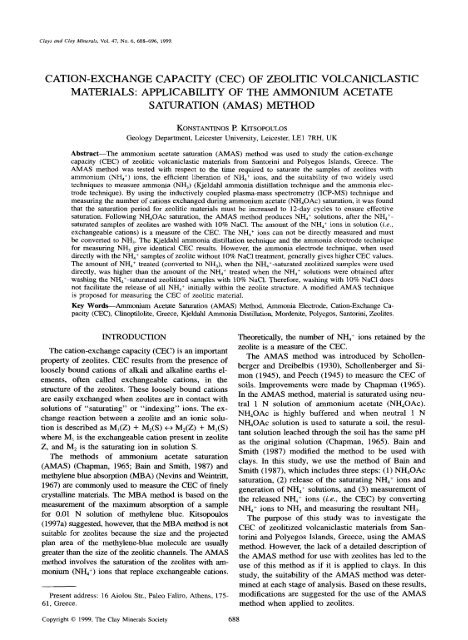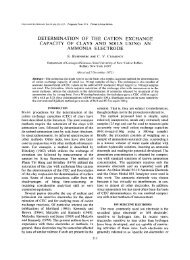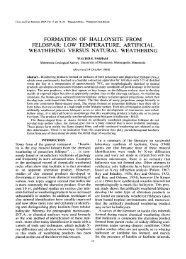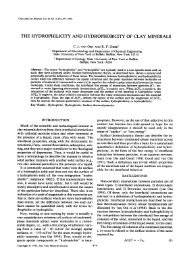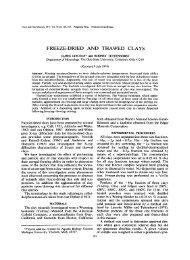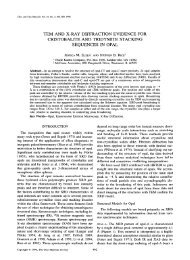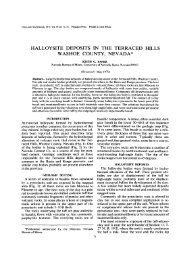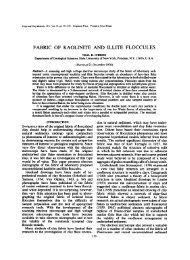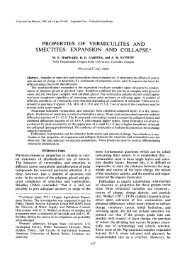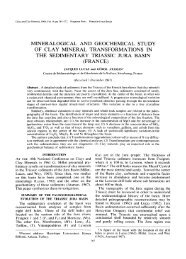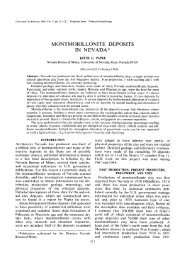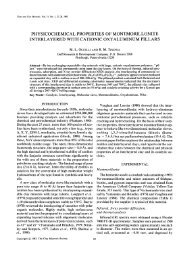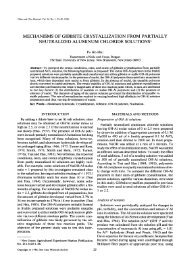Cation-exchange capacity (cec) of zeolitic - Clay Minerals Society
Cation-exchange capacity (cec) of zeolitic - Clay Minerals Society
Cation-exchange capacity (cec) of zeolitic - Clay Minerals Society
Create successful ePaper yourself
Turn your PDF publications into a flip-book with our unique Google optimized e-Paper software.
<strong>Clay</strong>s and <strong>Clay</strong> <strong>Minerals</strong>, Vol. 47, No. 6. 688-696, 1999.<br />
CATION-EXCHANGE CAPACITY (CEC) OF ZEOLITIC VOLCANICLASTIC<br />
MATERIALS: APPLICABILITY OF THE AMMONIUM ACETATE<br />
SATURATION (AMAS) METHOD<br />
KONSTANTINOS P. KITSOPOULOS<br />
Geology Department, Leicester University, Leicester, LE1 7RH, UK<br />
Abstract--The ammonium acetate saturation (AMAS) method was used to study the cation-<strong>exchange</strong><br />
<strong>capacity</strong> (CEC) <strong>of</strong> <strong>zeolitic</strong> volcaniclastic materials from Santorini and Polyegos Islands, Greece. The<br />
AMAS method was tested with respect to the time required to saturate the samples <strong>of</strong> zeolites with<br />
ammonium (NH4 +) ions, the efficient liberation <strong>of</strong> NH4 + ions, and the suitability <strong>of</strong> two widely used<br />
techniques to measure ammonia (NH3) (Kjeldahl ammonia distillation technique and the ammonia elec-<br />
trode technique). By using the inductively coupled plasma-mass spectrometry (ICP-MS) technique and<br />
measuring the number <strong>of</strong> cations <strong>exchange</strong>d during ammonium acetate (NH4OAc) saturation, it was found<br />
that the saturation period for <strong>zeolitic</strong> materials must be increased to 12-day cycles to ensure effective<br />
saturation. Following NHaOAc saturation, the AMAS method produces NH4 + solutions, after the NH4 §<br />
saturated samples <strong>of</strong> zeolites are washed with 10% NaC1. The amount <strong>of</strong> the NH4 + ions in solution (i.e.,<br />
<strong>exchange</strong>able cations) is a measure <strong>of</strong> the CEC. The NH4 + ions can not be directly measured and must<br />
be converted to NH 3. The Kjeldahl ammonia distillation technique and the ammonia electrode technique<br />
for measuring NH 3 give identical CEC results. However, the ammonia electrode technique, when used<br />
directly with the NH4 + samples <strong>of</strong> zeolite without 10% NaC1 treatment, generally gives higher CEC values.<br />
The amount <strong>of</strong> NH4 + treated (converted to NH3), when the NH4+-saturated zeolitized samples were used<br />
directly, was higher than the amount <strong>of</strong> the NH4 + treated when the NH4 § solutions were obtained after<br />
washing the NH4+-saturated zeolitized samples with 10% NaC1. Therefore, washing with 10% NaC1 does<br />
not facilitate the release <strong>of</strong> all NH4 + initially within the zeolite structure. A modified AMAS technique<br />
is proposed for measuring the CEC <strong>of</strong> <strong>zeolitic</strong> material.<br />
Key Words~Ammonium Acetate Saturation (AMAS) Method, Ammonia Electrode, <strong>Cation</strong>-Exchange Ca-<br />
pacity (CEC), Cfinoptilolite, Greece, Kjeldahl Ammonia Distillation, Mordenite, Polyegos, Santorini, Zeolites.<br />
INTRODUCTION<br />
The cation-<strong>exchange</strong> <strong>capacity</strong> (CEC) is an important<br />
property <strong>of</strong> zeolites. CEC results from the presence <strong>of</strong><br />
loosely bound cations <strong>of</strong> alkali and alkaline earths el-<br />
ements, <strong>of</strong>ten called <strong>exchange</strong>able cations, in the<br />
structure <strong>of</strong> the zeolites. These loosely bound cations<br />
are easily <strong>exchange</strong>d when zeolites are in contact with<br />
solutions <strong>of</strong> "saturating" or "indexing" ions. The ex-<br />
change reaction between a zeolite and an ionic solu-<br />
tion is described as MI(Z ) -F M2(S) ~ M2(Z) + Mx(S)<br />
where Mx is the <strong>exchange</strong>able cation present in zeolite<br />
Z, and M2 is the saturating ion in solution S.<br />
The methods <strong>of</strong> ammonium acetate saturation<br />
(AMAS) (Chapman, 1965; Bain and Smith, 1987) and<br />
methylene blue absorption (MBA) (Nevins and Weintritt,<br />
1967) are commonly used to measure the CEC <strong>of</strong> finely<br />
crystalline materials. The MBA method is based on the<br />
measurement <strong>of</strong> the maximum absorption <strong>of</strong> a sample<br />
for 0.01 N solution <strong>of</strong> methylene blue. Kitsopoulos<br />
(1997a) suggested, however, that the MBA method is not<br />
suitable for zeolites because the size and the projected<br />
plan area <strong>of</strong> the methylene-blue molecule are usually<br />
greater than the size <strong>of</strong> the <strong>zeolitic</strong> channels. The AMAS<br />
method involves the saturation <strong>of</strong> the zeolites with am-<br />
monium (NH4 +) ions that replace <strong>exchange</strong>able cations.<br />
Present address: 16 Aiolou Str., Paleo Faliro, Athens, 175-<br />
61, Greece.<br />
Copyright 9 1999, The <strong>Clay</strong> <strong>Minerals</strong> <strong>Society</strong> 688<br />
Theoretically, the number <strong>of</strong> NH4 + ions retained by the<br />
zeolite is a measure <strong>of</strong> the CEC.<br />
The AMAS method was introduced by Schollen-<br />
berger and Dreibelbis (1930), Schollenberger and Si-<br />
mon (1945), and Peech (1945) to measure the CEC <strong>of</strong><br />
soils. Improvements were made by Chapman (1965).<br />
In the AMAS method, material is saturated using neu-<br />
tral 1 N solution <strong>of</strong> ammonium acetate (NH4OAc).<br />
NH4OAc is highly buffered and when neutral 1 N<br />
NHnOAc solution is used to saturate a soil, the resul-<br />
tant solution leached through the soil has the same pH<br />
as the original solution (Chapman, 1965). Bain and<br />
Smith (1987) modified the method to be used with<br />
clays. In this study, we use the method <strong>of</strong> Bain and<br />
Smith (1987), which includes three steps: (1) NH4OAc<br />
saturation, (2) release <strong>of</strong> the saturating NH4 § ions and<br />
generation <strong>of</strong> NH4 + solutions, and (3) measurement <strong>of</strong><br />
the released NH4 + ions (i,e., the CEC) by converting<br />
NH4 + ions to NH 3 and measuring the resultant NH 3.<br />
The purpose <strong>of</strong> this study was to investigate the<br />
CEC <strong>of</strong> zeolitized volcaniclastic materials from San-<br />
torini and Polyegos Islands, Greece, using the AMAS<br />
method. However, the lack <strong>of</strong> a detailed description <strong>of</strong><br />
the AMAS method for use with zeolites has led to the<br />
use <strong>of</strong> this method as if it is applied to clays. In this<br />
study, the suitability <strong>of</strong> the AMAS method was deter-<br />
mined at each stage <strong>of</strong> analysis. Based on these results,<br />
modifications are suggested for the use <strong>of</strong> the AMAS<br />
method when applied to zeolites.
Vol. 47, No. 6, 1999 CEC <strong>of</strong> zeolites: ammonium acetate saturation 689<br />
o 0 0<br />
%<br />
South Aegean Sea Volcanic arc<br />
U<br />
,00 km<br />
I<br />
Figure 1. South Aegean Sea Volcanic Arc (dashed line). 1:<br />
Santorini, 2: Polyegos.<br />
MATERIALS<br />
Zeolitized pyroclastic materials from the Santorini<br />
and Polyegos Islands <strong>of</strong> the South Aegean Sea Vol-<br />
canic Arc, Greece (Figure 1) were used in this study.<br />
At Santorini Island (Figure 2), clinoptilolite and smec-<br />
tite or illite-smectite have replaced the vitreous matrix<br />
<strong>of</strong> the Akrotiri pyroclastics. The clinoptilolite was<br />
characterized by X-ray diffraction (XRD), thermal<br />
tests, and electron microprobe analysis. Clinoptilolite<br />
ranges from 40 to 75%. Tsolis-Katagas and Katagas<br />
(1989) proposed that the formation <strong>of</strong> zeolites resulted<br />
from the activity <strong>of</strong> interstitial water in the volcani-<br />
clastic material. According to these authors, the alter-<br />
ation minerals are not related to vertical or lateral zo-<br />
nation, and the irregular distribution <strong>of</strong> the assemblag-<br />
es is attributed to variations in heat flow, ionic activity<br />
in interstitial waters, and permeability. Kitsopoulos<br />
(1997b) suggested that a typical zeolitization model,<br />
which involves successive stages <strong>of</strong> alteration <strong>of</strong> the<br />
outer parts <strong>of</strong> glass shards to clays, dissolution <strong>of</strong><br />
glass, and finally precipitation <strong>of</strong> clinoptilolites in cav-<br />
ities <strong>of</strong> the previously dissolved glass shards, may not<br />
be applied as such. Instead, the clinoptilolites formed<br />
as a result <strong>of</strong> reactions between solid and fluid com-<br />
ponents within the glass shards, which acted as small<br />
semi-closed subdomains. The composition <strong>of</strong> the cli-<br />
noptilolite ranges from (Na2.12K2.56Ca040Mg0.19)(Si29.97<br />
A16.08 072)'24/-/20 and (Na2.60 Kz28 Ca0.48 Mgo.27 ) (5i29.71<br />
A16.20072).24H20 to (Na1.56K1.26Cal.19Mg0.58)(Siz9.35A16.71<br />
O72).24H20 (Kitsopoulos, 1995a, 1995b).<br />
On Polyegos Island (Figure 3), the authigenic minerals<br />
are mainly mordenite and illite, and more rarely<br />
illite-smectite. Mordenite ranges from 50 to 80%. Clinoptilolite<br />
(heulandite type 3) was found within a few<br />
samples. Kitsopoulos (1997c) suggested that heulandite-type<br />
minerals were the primary precursors for<br />
mordenite. Mordenite formed as a result <strong>of</strong> elevated<br />
temperature and high Na + concentration. In addition<br />
to mordenite <strong>of</strong> composition (Cao.68Mg0.49Na4.05K0.52)<br />
(Si41.06 A16.94 O96)'24H20, a K-rich mordenite occurs<br />
<strong>of</strong> composition (Cal.2o~lgo.2oNa2.31K2.39)(Si4o.61A17,41096)<br />
9 241-120 (Kitsopoulos, 1995a, Kitsopoulos and Dunham,<br />
1998).<br />
METHODS<br />
The ammonium acetate saturation (AMAS) method<br />
NH4OAc saturation. Zeolite powders <strong>of</strong> the
690 Kitsopoulos <strong>Clay</strong>s and <strong>Clay</strong> <strong>Minerals</strong><br />
Figure 2. Geological map <strong>of</strong> the Akrotiri area <strong>of</strong> Santorini island (IGME, 1980).<br />
supernatent liquid was transferred to a Teflon bottle<br />
and the procedure repeated six times. Then, the bottle<br />
was filled to 100 mL with deionized water. After wash-<br />
ing the NH4+-saturated zeolite samples with NaC1, the<br />
NH4 + ions, which were retained by the zeolites after<br />
NHaOAc saturation, were replaced by Na + ions, and<br />
NH4 + solutions were obtained. The released NH4 § ions<br />
is a measure <strong>of</strong> the CEC <strong>of</strong> the samples.<br />
Conversion <strong>of</strong> NH4 + to NH3 and the determination <strong>of</strong><br />
the CEC. Because NH4 + ions can not be directly mea-<br />
sured, they are converted using a strong base to NH 3,<br />
which may be analyzed by Kjeldahl ammonia distilla-<br />
tion, by using an ammonia electrode (Busenberg and<br />
Clemency, 1973), or by spectrophotometry (Fraser and<br />
Russel, 1969). In this study, the Kjeldahl ammonia dis-<br />
tillation and the ammonia electrode techniques were<br />
used.<br />
Kjeldahl ammonia distillation technique<br />
To convert NH4 + to NH 3, 50 mL <strong>of</strong> the NHa§ -<br />
taining solutions were transferred to a distillation flask
Vol. 47, No. 6, 1999 CEC <strong>of</strong> zeolites: ammonium acetate saturation 691<br />
Figure 3. Geological map <strong>of</strong> Polyegos island (Kanaris,<br />
1989).<br />
and diluted with 200 mL <strong>of</strong> NH3-free deionized water.<br />
One gram <strong>of</strong> granulated zinc (a few fragments <strong>of</strong> po-<br />
rous porcelain are suitable also) was added to the flask<br />
to promote regular ebullition in the subsequent distil-<br />
lation. An amount <strong>of</strong> 100 mL <strong>of</strong> 0.1 N HC1 was placed<br />
in the receiver. The flask was adjusted so the end <strong>of</strong><br />
the condenser just dips into the acid. An amount <strong>of</strong><br />
100 mL <strong>of</strong> 10% NaOH was placed in the funnel above<br />
the distillation flask. The 10% NaOH was quickly in-<br />
troduced to the distillation flask; when all the alkali<br />
passed, the tap was securely closed. The addition <strong>of</strong><br />
the 10% NaOH produced the complete conversion <strong>of</strong><br />
the NH4 + ions to NH 3 by: NH4 + + OH ~ NH 3 +<br />
H20. The contents <strong>of</strong> the flask were boiled gently for<br />
1 h and all the NH3 passed through to the HC1 <strong>of</strong><br />
the receiver. The tap was opened before switching <strong>of</strong>f<br />
the heating unit, the top <strong>of</strong> the condenser disconnected,<br />
and the receiver lowered and rinsed with deionized<br />
water. A few drops <strong>of</strong> methyl red or a mixture <strong>of</strong> meth-<br />
yl red-bromocresol green was added in the receiver<br />
flask. The excess <strong>of</strong> HC1 in the receiver was measured<br />
by titration using 0.1 N NaOH. The accuracy <strong>of</strong> the<br />
distillation experiments was determined by comparing<br />
to standard 1 M NH4C1 solutions.<br />
Ammonia electrode technique<br />
In aqueous solutions, the potential recorded by an<br />
ammonia electrode is related to the activity <strong>of</strong> the dis-<br />
solved NH3. Thus, NH4 + may be ana/yzed as follows.<br />
The solutions <strong>of</strong> NH4 + are treated with strong NaOH<br />
and converted to NH3, which then may be analyzed by<br />
the ammonia electrode. This technique is much less te-<br />
dious than distillation. The ammonia electrode is con-<br />
nected either to a pH meter or to an ion meter/analyzer,<br />
and a small magnetic stirrer (air-driven stirrers are not<br />
recommended). For the use <strong>of</strong> a pH meter, a calibration<br />
curve <strong>of</strong> known NH 3 concentrations vs. mV (potential)<br />
is first determined. The concentration <strong>of</strong> Nil 3 is then<br />
estimated using the calibration curve. An ion meter/<br />
analyzer measures directly the concentration <strong>of</strong> NtI 3. In<br />
this study, an Orion 95-12 ammonia electrode, and a<br />
Jenway 3045 pH/mV#C/ion analyzer were used. To<br />
convert NH4 + to NH3, 50 mL <strong>of</strong> solution <strong>of</strong> NH4 § were<br />
added to a 100-mL Pyrex beaker containing a Teflon<br />
covered stimng bar. The ammonia electrode was im-<br />
mersed into the solution and no entrapment <strong>of</strong> air under<br />
the concave tip was allowed. Stirring was commenced<br />
and 0.5 mL <strong>of</strong> 10 M NaOH was added by syringe.<br />
Recordings <strong>of</strong> the NH 3 content were obtained at 0.5-<br />
min intervals until a constant level was achieved. The<br />
electrode was calibrated every 2 h using standard<br />
NH4C1 solutions <strong>of</strong> 1, 0.1, 0.01, 0.001, and 0.0001 M.<br />
The accuracy <strong>of</strong> the measurements was determined by<br />
comparing to standard 1 M NH4C1 solutions.<br />
An advantage <strong>of</strong> the ammonia electrode technique<br />
is that NHa+-saturated samples may be used without<br />
prior washing with 10% NaC1. The measurement <strong>of</strong><br />
CEC is both simple and rapid. In this study, NH4 + ions<br />
<strong>of</strong> the zeolites were analyzed also, but without wash-<br />
ing the samples <strong>of</strong> the NH4+-saturated zeolites with<br />
10% NaC1. An amount <strong>of</strong> 50-150 mg <strong>of</strong> the samples<br />
<strong>of</strong> NH4 + saturated zeolites was placed in a 100-mL<br />
Pyrex beaker containing a Teflon covered stirring bar,<br />
Deionized water (50 mL) was added and the solution<br />
stirred to suspend the sample. The electrode was im-<br />
mersed into the suspension taking care to prevent en-<br />
trapment <strong>of</strong> air under the concave tip. An amount <strong>of</strong><br />
0.5 mL <strong>of</strong> 10 M NaOH was added by syringe and<br />
analyses <strong>of</strong> NH3 were taken at 0.5-min intervals until<br />
a constant level was achieved. The electrode was cal-<br />
ibrated every 2 h using NH4C1 solutions <strong>of</strong> 1, 0.1,<br />
0.01, 0.001, and 0.0001 M. The accuracy <strong>of</strong> the mea-<br />
surements was determined by comparing to standard<br />
1 M NH4C1 solutions.<br />
RESULTS AND DISCUSSION<br />
Exchangeable cations measured by ICP-MS after<br />
each saturation cycle are given in Table 1. The 8-d<br />
saturation period was sufficient to <strong>exchange</strong> Ca and<br />
Mg from the zeolites; the analyses for Ca and Mg after<br />
9 d were extremely low. The results from the Santorini<br />
samples are consistent with the mineralogy where the<br />
tuffs are dominated by Na, K-rich clinoptilolites and<br />
Ca and Mg are lower in amount. The results show that<br />
Na and K account for 70-95% <strong>of</strong> the total <strong>exchange</strong>-<br />
able cations in the Santorini samples.<br />
For the Polyegos samples, Na and K also dominate.<br />
They account for 84 to 91% <strong>of</strong> the total <strong>exchange</strong>able<br />
cations, whereas Ca and Mg account for only 9-16%<br />
<strong>of</strong> the <strong>exchange</strong>able cations in samples P5, P8, P10,<br />
P13, and P21. The release <strong>of</strong> low amounts <strong>of</strong> Ca and<br />
Mg suggests that most <strong>of</strong> Ca and Mg may be fixed in<br />
mordenite or fixed relative to NH4 § The high amount
692 Kitsopoulos <strong>Clay</strong>s and <strong>Clay</strong> <strong>Minerals</strong><br />
Table 1. Na, K, Ca, and Mg analyses (ppm) by ICP-MS for different periods <strong>of</strong> ammonium acetate saturation <strong>of</strong> zeolitized<br />
volcaniclastics from Santorini (S) and Polyegos (P) Islands, Greece.<br />
Sample <strong>Cation</strong>s 1 2 3 4 5 6 7 8 9 10<br />
Santonnilsland<br />
S108 Na 876 78 20 10 1 20 7 4 18 8<br />
K 652 140 40 18 6 18 23 20 25 13<br />
Ca 88 22 9 9 6 5 7 4 5 4<br />
Mg 41 9 4 3 3 4 4 2 2 3<br />
Sl17 Na 643 110 31 6 28 26 t2 30 31 8<br />
K 84 47 29 3 19 19 7 18 12 15<br />
Ca 83 29 10 11 7 5 4 3 1 3<br />
Mg 8 4 3 0 1 1 0 1 1 1<br />
S126 Na 1092 90 13 5 16 6 6 4 18 13<br />
K 555 128 37 11 16 1 18 24 23 9<br />
Ca 148 32 12 9 6 5 6 4 4 4<br />
Mg 27 8 5 4 4 3 3 2 4 2<br />
S130 Na 1288 144 26 21 6 23 23 28 29 7<br />
K 385 124 40 21 5 17 18 21 18 12<br />
Ca 194 28 12 9 4 3 3 2 3 2<br />
Mg 16 7 7 4 1 2 2 2 1 2<br />
S140 Na 709 57 8 10 6 19 21 7 16 9<br />
K 251 54 13 16 6 20 18 22 16 5<br />
Ca 293 48 14 13 9 8 10 7 4 5<br />
Mg 55 10 4 3 2 3 2 2 3 3<br />
Polyegos Island<br />
P5 Na 614 45 9 15 26 25 3 2 24 18<br />
K 337 72 20 14 25 25 19 19 21 19<br />
Ca 165 21 5 8 3 3 3 2 3 3<br />
Mg 20 3 2 2 2 2 0 0 2 1<br />
P8 Na 993 77 27 21 17 21 31 45 36 21<br />
K 234 60 32 24 11 15 23 31 19 22<br />
Ca 184 34 14 14 10 12 12 7 5 7<br />
Mg 16 3 1 l 0 1 1 1 0 1<br />
P10 Na 864 80 34 21 28 37 5 4 23 11<br />
K 360 93 42 21 31 38 24 22 32 28<br />
Ca 62 11 4 3 3 4 5 4 4 3<br />
Mg 46 9 5 3 4 2 3 2 2 2<br />
P13 Na 937 115 31 29 32 30 7 11 19 17<br />
K 516 132 43 26 23 23 3 7 13 12<br />
Ca 145 53 16 14 14 13 14 10 9 7<br />
Mg 27 9 3 2 3 3 2 2 1 2<br />
P21 Na 307 38 7 -3 12 38 1 1 8 3<br />
K 94 30 4 -7 10 35 25 23 21 8<br />
Ca 15 3 0 0 1 1 1 1 0 1<br />
Mg 24 6 3 2 2 3 2 1 2 2<br />
<strong>of</strong> K is related to exceptionally K-rich mordenite (Kit-<br />
sopoulos and Dunham, 1998) and also to clinoptilolite<br />
(heulandite type 3) (Kitsopoulos, 1997c).<br />
The bulk <strong>of</strong> cation <strong>exchange</strong> occurred within 2 d.<br />
Na and K <strong>exchange</strong>d slightly faster from clinoptilolite<br />
than from mordenite. The Santorini samples released<br />
85-95% <strong>of</strong> the <strong>exchange</strong>able cations in the first three<br />
days, whereas the Polyegos sample released 75-90%<br />
in the same time. Na and K in the Santorini samples<br />
decreased between 4-6 d. However, after this de-<br />
crease, 20-30 ppm Na, K were released between 6-9<br />
d. For the Polyegos samples, K was released again<br />
following the initial release, between 6-8 d, and some<br />
samples showed additional release <strong>of</strong> Na between 8-<br />
10 d. In conclusion, there is an active release <strong>of</strong> cat-<br />
Days<br />
ions in zeolites even after 5 d, the maximum saturation<br />
period for clays.<br />
Although clays can be adequately saturated in short<br />
periods (Mackenzie, 1951; Bain and Smith, 1987), ze-<br />
olites require longer periods for saturation. Noda<br />
(1980), for example, used a saturation period <strong>of</strong> -4<br />
wk for clinoptilolite, although such periods are incon-<br />
venient. <strong>Cation</strong>s will probably be continuously re-<br />
leased even after an extensive saturation period. The<br />
main objective, however, is to provide near complete<br />
NH4OAc saturation within a reasonable period. There-<br />
fore, the results presented here suggest a NH4OAc sat-<br />
uration period for zeolites <strong>of</strong> 12 days.<br />
The CEC values in Table 2 were obtained by Kjel-<br />
dahl anmaonia distillation <strong>of</strong> NH4 + solutions obtained
Vol. 47, No. 6, 1999 CEC <strong>of</strong> zeolites: ammonium acetate saturation 693<br />
Table 2. CEC values (meq/100 g) <strong>of</strong> zeolitized volcaniclas-<br />
tics from Santorini (S) and Polyegos (P) Islands, Greece. The<br />
CEC values were obtained using the Kjeldahl ammonia dis-<br />
tillation technique with the NH4 + solutions obtained by wash-<br />
ing the NH4+-saturated samples <strong>of</strong> zeolites with 10% NaC1.<br />
sample x Y Mean [(Y X)/2]<br />
Sant<strong>of</strong>iniIsland<br />
S103 184.44 184.83 184.63 0.20<br />
S104 117.11 117.11 117.11 0.00<br />
S105 109.57 109.86 109.71 0.15<br />
S106 161.57 162.17 161.87 0.30<br />
S108 130.54 130.91 130.72 0.19<br />
Sll0 183.42 184.43 183.92 0.51<br />
Sl13 119.47 119.47 119.47 0.00<br />
Sl15 120.39 120.87 120.63 0.24<br />
Sl16 170.92 171.15 171.03 0.12<br />
Sl17 111.46 111.66 111.56 0.10<br />
Sl19 145.25 145.39 145.32 0.07<br />
S120 151.45 152.08 151.76 0.32<br />
S121 175.18 175.60 175.39 0.21<br />
$124 199.98 200.77 200.37 0.40<br />
S126 168.65 169.79 169.22 0.57<br />
S130 188.92 189.29 189.10 0.19<br />
S132 126.20 126.45 126.19 0.13<br />
S137 182.14 182.42 182.28 0.14<br />
S139 142.77 143.48 143.12 0.35<br />
S140 142.34 142.58 142.46 0.12<br />
S141 187.55 187.55 187.55 0.00<br />
S142 163.00 163.19 163.09 0.09<br />
S145 146.97 148.06 147.51 0.55<br />
S146 117.63 118.15 117.89 0.26<br />
XMean 0.22<br />
Polyegos Island<br />
P2 109.22 110.13 109.67 0.45<br />
P4 142.10 142.74 142.42 0.32<br />
P5 132.43 133.63 133.03 0.60<br />
P6 86.85 87.84 87.34 0.50<br />
P8 128.33 128.52 128.43 0.09<br />
P10 102.71 103.29 103.00 0.29<br />
Pll 132.32 133.22 132.77 0.45<br />
P13 157.21 157.30 157.25 0.05<br />
P14 118.00 118.34 118.17 0.17<br />
P17 154.61 155.78 155.19 0.58<br />
P19 109.70 109.91 109.80 0.10<br />
P21 18.04 18.15 18.09 0.05<br />
P23 1.67 1.76 1.71 0.05<br />
P27 2.31 2.47 2.39 0.08<br />
P30 2.27 2.37 2.33 0.06<br />
P34 146.43 147.23 146.83 0.40<br />
2Mean 0.27<br />
1 Standard deviation: 0.16.<br />
2 Standard deviation: 0.21.<br />
by treatment with 10% NaC1. Two values were deter-<br />
mined for each sample, with the lower value given as<br />
X and the higher value as Y. The mean values <strong>of</strong> CEC<br />
range from 109.71 to 200.37 meq/100 g for the San-<br />
torini samples, and from 1.71 to 157.25 meq/100 g for<br />
Polyegos. These values are larger than the variation<br />
(0.22 --- 0.16 and 0.27 _ 0.21) between the pair <strong>of</strong><br />
measurements. The three Polyegos samples (P23, P27,<br />
and P30), which showed very low CEC values (1.7-<br />
2.5 meq/100 g), contain kaolinite, halloysite, alunite,<br />
Table 3. CEC values (meq/100 g) <strong>of</strong> zeolitized volcaniclas-<br />
tics from Santorini (S) and Polyegos (P) Islands, Greece. The<br />
CEC values were obtained using the ammonia electrode tech-<br />
nique with the NH4 § solutions obtained by washing the NH4 +-<br />
saturated samples <strong>of</strong> zeolites with 10% NaC1.<br />
sample X Y Mean [(Y - X)/2]<br />
Sant<strong>of</strong>ini Island<br />
S103 185.04 185.04 185.04 0.00<br />
S104 117.21 117.28 117.24 0.04<br />
S105 111.24 111.44 111.35 0.10<br />
S106 164.01 164.24 164.13 0.12<br />
S108 133.75 133.89 133.82 0.07<br />
$110 184.99 185.18 185.09 0.09<br />
Sl13 120.06 120.10 120.08 0.02<br />
Sl15 122.22 122.22 122.22 0.00<br />
Sl16 171.14 171.14 171.14 0.00<br />
Sl17 112.52 112.81 112.67 0.15<br />
Sl19 147.67 147.89 147.78 0.11<br />
S120 154.06 154.11 154.08 0.03<br />
S121 176.82 176.83 176.82 0.01<br />
S124 201.90 202.10 202.01 0.10<br />
S126 169.19 169.57 169.38 0.19<br />
S130 189.92 190.01 189.97 0.05<br />
S132 129.68 130.00 129.84 0.16<br />
S137 182.46 182.56 182.51 0.05<br />
S139 145.83 145.97 145.90 0.07<br />
S140 144.79 145.12 144.98 0.16<br />
$141 188.55 188.61 188.58 0.03<br />
S142 163.42 163.43 163.42 0.01<br />
S145 150.33 150.35 150.33 0.01<br />
S146 118.18 118.51 118.33 0.16<br />
tMean 0.07<br />
Polyegos Island<br />
P2 113.01 113.36 113.18 0.17<br />
P4 143.62 143.71 143.66 0.05<br />
P5 134.27 134.62 134.44 0.17<br />
P6 89.34 89.45 89.44 0.05<br />
P8 128.02 128.39 128.20 0.18<br />
P10 103.38 103.39 103.38 0.01<br />
Pll 133.88 133.88 133.88 0.00<br />
P13 159.61 159.75 159.68 0.07<br />
P14 119.72 120.01 119.86 0.15<br />
P17 157.12 157.17 157.14 0.02<br />
P19 112.08 112.08 112.08 0.00<br />
P21 18.76 18.89 18.82 0.06<br />
P23 1.67 1.74 1.70 0.04<br />
P27 2.38 2.46 2.42 0.04<br />
P30 2.36 2.37 2.36 0.01<br />
P34 148.33 148.75 148.54 0.21<br />
2Mean 0.08<br />
1 Standard deviation: 0.06.<br />
2 Standard deviation: 0.07.<br />
and amorphous silica in variable amounts, but no ze-<br />
olite minerals. Sample P21 from Polyegos, with a CEC<br />
<strong>of</strong> -18 meq/100 g, is a kaolinite sample, but some<br />
mordenite was present also. Therefore, the low CEC<br />
values for these four samples, relative to the other<br />
samples, are consistent with mineralogy. The results<br />
obtained using the standard 1 M NH4C1 solutions were<br />
very satisfactory (mean value 0.997, s.d. 0.028).<br />
The CEC values in Table 3 were obtained with an<br />
ammonia electrode and the NH4 + solutions obtained
694 Kitsopoulos <strong>Clay</strong>s and <strong>Clay</strong> <strong>Minerals</strong><br />
z<br />
240<br />
210<br />
I80<br />
i 150<br />
9 ~ 120<br />
<<br />
"~ 90<br />
~ 6o<br />
E<br />
~ 30<br />
= . x-<br />
SANTORINI - POLYEGOS<br />
30 60 90 120 150 180 210<br />
CEC (meq/100 g): Ammonia Electrode Technique (10% NaCI)<br />
I<br />
240<br />
Figure 4. CEC values (meq/100 g) obtained using the am-<br />
monia electrode technique with the NH~ + solutions obtained<br />
by washing the NH4+-saturated samples <strong>of</strong> zeolites with 10%<br />
NaC1 vs. CEC values (meq/100 g) obtained using the Kjeldahl<br />
ammonia distillation technique with the same NH4 + solutions.<br />
The correlation coefficient is 0.999 for the regression analy-<br />
sis.<br />
by treatment with 10% NaC1. The results are presented<br />
in the same way as for Table 2. The mean values <strong>of</strong><br />
CEC range from 111.35 to 202.01 meq/100 g for the<br />
Santorini samples, and from 1.70 to 159.68 meq/100<br />
g for Polyegos; values all much larger than the vari-<br />
ation (0.07 0.06 and 0.08 0.07) between the pair<br />
<strong>of</strong> measurements. The results obtained using the stan-<br />
dard 1 M NH4C1 solutions were very satisfactory<br />
(mean value 0.999, s.d. 0.019). Figure 4 shows the<br />
data <strong>of</strong> Tables 2 and 3 and indicates that the two tech-<br />
niques give similar results. However, the ammonia<br />
electrode technique can dramatically reduce the time<br />
<strong>of</strong> performing a CEC measurement,<br />
The CEC values in Table 4 were obtained with an<br />
ammonia electrode directly with the NH4+-saturated<br />
samples, but the samples were not treated with 10%<br />
NaC1. The results are presented following the format<br />
<strong>of</strong> Table 2. The mean values <strong>of</strong> CEC range from<br />
126.58 to 221.60 meq/100 g for the Santorini samples,<br />
and from 1.71 to 188.00 meq/100 g for the Polyegos<br />
samples; values all much larger than the variation<br />
(0.06 0.05 and 0.05 0.05) between the pair <strong>of</strong><br />
measurements. The results obtained using the standard<br />
1 M NHaC1 solutions were very satisfactory (mean<br />
value 1.000, s.d. 0.017).<br />
The results shown in Tables 3 and 4 indicate that<br />
the CEC values obtained from the NH4+-saturated<br />
samples were generally higher than those obtained<br />
from the NH4 + solutions obtained after washing with<br />
10% NaC1. Differences to 72.36 meq/100 g were re-<br />
corded for the Santorini samples and to 59.27 meq/<br />
Table 4. CEC values (meq/100 g) <strong>of</strong> zeolitized volcaniclas-<br />
tics from Santorini (S) and Polyegos (P) Islands, Greece. The<br />
CEC values were obtained using the ammonia electrode tech-<br />
nique directly with the NH4+-saturated samples <strong>of</strong> zeolites (no<br />
prior washing with 10% NaC1).<br />
Sample X Y Mean [(Y - X)/2]<br />
Sant<strong>of</strong>iniIsland<br />
$103 186.05 186.14 186.09 0.04<br />
S104 131.62 131.86 131.74 0.12<br />
S105 126.52 126.65 126.58 0.07<br />
S106 192.92 193.12 193.02 0.10<br />
S108 132.27 132.27 132.27 0.00<br />
Sll0 165.64 165.79 185.71 0.08<br />
Sl13 131.11 131.11 131.11 0.00<br />
Sl15 137.87 138.14 138.00 0.13<br />
Sl16 197.71 197.73 197.72 0.01<br />
$117 151.60 151.92 151.76 0.16<br />
Sl19 217.57 217.80 217.68 0.12<br />
$120 189.81 189.95 189.88 0.07<br />
$121 178.81 179.07 178.94 0.13<br />
S124 214.59 214.78 214.68 0.09<br />
S126 197.56 197.56 197.56 0.00<br />
$130 221.60 221.60 221.60 0.00<br />
S132 130.34 130.50 130.42 0.08<br />
S137 180.48 180.49 180.48 0.01<br />
S139 182.40 182.52 182.46 0.06<br />
S140 153.21 153.24 153.22 0.02<br />
S141 186.82 186.82 186.82 0,00<br />
S142 183.02 183.22 183.12 0.10<br />
$145 161.44 161.49 161.44 0.03<br />
$146 134.41 134.42 134.41 0.00<br />
tMean 0.06<br />
Polyegos Island<br />
P2 113.01 113.16 113.08 0.07<br />
P4 170.03 170.33 170.18 0.15<br />
P5 139.58 139.70 139.64 0.06<br />
P6 114.89 114.90 114.89 0.01<br />
P8 148.63 148.70 148.66 0.03<br />
P10 116.07 116.11 116.09 0.02<br />
Pll 187.90 188.11 188.00 0.11<br />
P13 161.73 161.75 161.74 0.01<br />
P14 150.92 151.15 151.04 0.12<br />
P17 179.59 179.59 179.59 0.00<br />
P19 169.01 169.14 169.07 0.06<br />
P21 33.29 33.39 33.34 0.05<br />
P23 1.66 1.76 1.71 0.05<br />
P27 2.46 2.46 2.46 0.00<br />
P30 2.38 2.39 2.38 0.01<br />
P34 160.02 160.02 160.02 0.00<br />
ZMean 0.05<br />
Standard deviation: 0.05.<br />
2 Standard deviation: 0.05.<br />
100 g for the Polyegos samples. Figure 5 is the plot<br />
<strong>of</strong> Table 4 vs. Table 3.<br />
It is unlikely that these differences in the CEC are<br />
related to laboratory or experimental conditions or in-<br />
terference problems from the electrode. Care was tak-<br />
en that a) the starting samples were well homogenized,<br />
b) duplicate measurements were randomly taken for<br />
all samples, c) NH4 § was treated by a strong alkali to<br />
ensure complete conversion to NH 3, and d) the accu-<br />
racy <strong>of</strong> the experiments was determined by using stan-
Vol. 47, No. 6, 1999 CEC <strong>of</strong> zeolites: ammonium acetate saturation 695<br />
2*O ~OmNl. ~LYEGO$<br />
~ 15o S<br />
* o<br />
90 y = 0 9292x + 29 044 --7~''<br />
E i ,~." ..... F~dudJng po]yegos ~ple~ p2L P23,1127 ~d p30<br />
,."~. - _ _ ~adudlag all S~tonm and Polycgos ~p]~<br />
~ [ 30 ~ .... 2"" ~ r = 10432x+ ii 908<br />
CEC (m~l~ g): ~a El~e T~iq~ (1~ NaCI)<br />
Figure 5. CEC values (meq/100 g) obtained using the am-<br />
monia electrode technique with the NH4 + solutions obtained<br />
by washing the NH4+-saturated samples <strong>of</strong> zeolites with 10%<br />
NaCI vs. CEC values (meq/100 g) obtained using the am-<br />
monia electrode technique directly with the NH4+-saturated<br />
samples <strong>of</strong> zeolites (no prior washing with 10% NaC1). The<br />
correlation coefficient is 0.948 (including all samples from<br />
Santorini and Polyegos) for the regression analysis. If the<br />
three kaolinite samples P23, P27, and P30 from Polyegos,<br />
which exhibit minimal differences in their CEC values, are<br />
omitted, then, the correlation coefficient value is 0.884. If P21<br />
is omitted also the correlation coefficient value is 0.823.<br />
dard 1 M NH4C1 solutions. Although ion selective<br />
electrodes may suffer in accuracy when ions <strong>of</strong> similar<br />
valency are present (Busenberg and Clemency, 1973),<br />
the ammonia electrode is not an ion selective elec-<br />
trode. The ammonia electrode is a gas-detecting elec-<br />
trode sensitive to dissolved ammonia (not ammonium).<br />
The electrode has a hydrophobic membrane permeable<br />
to ammonia, but not to any ionic species. Busenberg<br />
and Clemency (1973) used the electrode successfully<br />
with NH4+-saturated clays, and they found that the am-<br />
monia electrode has virtually no interferences, in con-<br />
trast to most other electrodes.<br />
Thus, the differences in CEC are not related to ex-<br />
perimental or laboratory conditions, or ion interference.<br />
Apparently, the NH3 obtained from the NHn+-saturated<br />
samples was higher than the NH3 produced by the NH4 +<br />
solutions obtained by washing the NH4+-saturated sam-<br />
pies with 10% NaC1. Presumably, the release <strong>of</strong> the<br />
saturating NH4 + ions, after the NHn+-saturated samples<br />
were washed with 10% NaC1, was not complete for the<br />
majority <strong>of</strong> samples used here and some NH4 + ions re-<br />
main trapped in the zeolite minerals.<br />
The CEC <strong>of</strong> zeolites should reflect the amount <strong>of</strong> a<br />
saturating ion (principally NH4 +) adsorbed at a specific<br />
pH when the zeolite samples come in contact with a<br />
relevant solution. Problems may occur in the measure-<br />
ment <strong>of</strong> the CEC <strong>of</strong> zeolites using methods that may<br />
be applicable to other minerals. For example, the in-<br />
sufficient <strong>exchange</strong> <strong>of</strong> NH4 + ions as described above<br />
is a serious drawback in applying AMAS to zeolites<br />
if the procedures <strong>of</strong> Bain and Smith (1987) for clays<br />
are followed. Other factors influencing the CEC may<br />
include improper grinding procedures (i.e., reducing<br />
size), the application <strong>of</strong> heat, the change <strong>of</strong> composi-<br />
tion <strong>of</strong> the zeolite to a single cationic form (e.g., Na<br />
<strong>exchange</strong>), or the change in nature and concentration<br />
<strong>of</strong> the saturating ion. The simultaneous application <strong>of</strong><br />
more than one <strong>of</strong> these treatments in all their possible<br />
combinations may further change the apparent CEC.<br />
By applying the various physical and chemical treat-<br />
ments we may obtain the highest possible CEC value<br />
for a zeolite sample. However, comparable CEC val-<br />
ues for zeolites may be difficult to obtain. Instead, a<br />
technique that provides a common approach and com-<br />
parable CEC values for zeolites is most valuable.<br />
SUGGESTED TECHNIQUE FOR MEASURING<br />
THE CEC OF ZEOLITES<br />
The technique proposed here consists <strong>of</strong> three major<br />
parts: (1) sample preparation, (2) saturation <strong>of</strong> the sample<br />
with NH4OAc and <strong>exchange</strong>, and (3) conversion <strong>of</strong> NH4 +<br />
ions to NH 3 and measurement <strong>of</strong> the NH 3 produced.<br />
Sample preparation<br />
Fine powders (
696 Kitsopoulos <strong>Clay</strong>s and <strong>Clay</strong> <strong>Minerals</strong><br />
night saturation should occur in a tightly sealed cen-<br />
trifuge tube placed sideways on a stirring plate to en-<br />
sure a well-mixed saturating NH4OAc solution and<br />
sample. The samples <strong>of</strong> NH4+-saturated zeolites are<br />
then left to dry thoroughly without heating. If the<br />
NHa+-saturated samples are dried in an oven, the tem-<br />
perature should not exceed 40-50~ Do not store or<br />
open ammonia reagent bottles in the same lab where<br />
the CEC experiments are processed.<br />
Conversion <strong>of</strong> the NH4 + ions to NH 3 and<br />
measurement <strong>of</strong> the NH 3 produced<br />
The samples <strong>of</strong> NH4+-saturated zeolites are not<br />
washed with any salt solution, but these samples are<br />
used directly. Kjeldahl ammonia distillation or the am-<br />
monia electrode are two satisfactory techniques rec-<br />
ommended for measuring NH3.<br />
The Kjeldahl ammonia distillation procedure is ap-<br />
pried as described above (see Methods: Kjeldahl am-<br />
monia distillation technique). Instead <strong>of</strong> NH4 + solutions,<br />
50-150 mg <strong>of</strong> the dried, NH4+-saturated samples <strong>of</strong> ze-<br />
orites are weighed and transferred to a distillation flask<br />
and the Kjeldahl ammonia distillation procedure is fol-<br />
lowed. The CEC can be calculated as CEC =<br />
{ [(Vncl)(NHcl) - (V~aoH)(NNaOH)]/(W) } 100, where CEC<br />
is expressed in meq/100 g, (VHc0 is the volume (in mL)<br />
<strong>of</strong> the HC1, (Nnci) is the normality <strong>of</strong> the HC1, (V~oH)<br />
is the volume (in mL) <strong>of</strong> the NaOH used in the titration,<br />
(NNaoa) is the normality <strong>of</strong> the NaOH, and (w) is the<br />
weight <strong>of</strong> the sample in g. Note that NH3 may normally<br />
be distilled within a period <strong>of</strong> 1 h. However, care must<br />
be taken by routinely determining the pH.<br />
The ammonia electrode is used directly with the<br />
NH4+-saturated samples <strong>of</strong> zeolites as described above<br />
(see Methods: Ammonia electrode technique). The CEC<br />
is obtained from CEC = [(C)(V)/(w)]100, where CEC<br />
is expressed in meq/100 g, (C) is the concentration <strong>of</strong><br />
ammonia in moles/L, (V) is the volume (in L) <strong>of</strong> water<br />
added, and (w) is the weight <strong>of</strong> the sample in g.<br />
ACKNOWLEDGMENTS<br />
I am grateful to A. Dunham <strong>of</strong> the Geology Department <strong>of</strong><br />
Leicester University for supervising my Ph.D. work during a<br />
very difficult period <strong>of</strong> his life, reading this manuscript, and<br />
making very useful comments. Sadly, Pr<strong>of</strong>. Dunham passed<br />
away on January 18th <strong>of</strong> 1998. He is greatly missed.<br />
H. Louka is thanked for checking the manuscript, and the<br />
Geology Department <strong>of</strong> Leicester University for providing the<br />
necessary analytical facilities. Critical reviews and sugges<br />
tions by M. Walthall and L. Warren helped improve the man-<br />
uscript greatly. The State Scholarship Foundation (SSF) <strong>of</strong><br />
Greece is acknowledged for providing financial support. The<br />
author thanks E. Mansley, N. Marsh, R. Kelly, and S. Button<br />
<strong>of</strong> the Geology Department <strong>of</strong> Leicester University for their<br />
help on technical aspects.<br />
REFERENCES<br />
Bain, D.C. and Smith, B.EL. (1987) Chemical analysis. In A<br />
Handbook <strong>of</strong> Determinative Methods in <strong>Clay</strong> Mineralogy,<br />
M.J. Wilson, ed., Blackie, Glasgow, 248-274.<br />
Busenberg, E. and Clemency, C.V. (1973) Determination <strong>of</strong><br />
the cation <strong>exchange</strong> <strong>capacity</strong> <strong>of</strong> clays and soils using an<br />
ammonia electrode. <strong>Clay</strong>s and <strong>Clay</strong> <strong>Minerals</strong>, 21, 213-217.<br />
Chapman, H.D. ( 1965 ) <strong>Cation</strong> <strong>exchange</strong> <strong>capacity</strong>. In Methods<br />
<strong>of</strong> Soil Analysis (Number 9 in the Series Agronomy), Part<br />
2, A. Black, ed., American Institute <strong>of</strong> Agronomy, Madi-<br />
son, Wisconsin, 891-901.<br />
Fraser, A.R. and Russel, J.D. (1969) A spectrophotometric<br />
method for determination <strong>of</strong> cation <strong>exchange</strong> <strong>capacity</strong> <strong>of</strong><br />
clay minerals. <strong>Clay</strong> <strong>Minerals</strong>, 8, 229-230.<br />
IGME (1980) Geological map "Thera". 1: 50,000. Institute<br />
<strong>of</strong> Geological and Mineralogical Research <strong>of</strong> Greece<br />
(IGME), Athens.<br />
Kanaris, I.T. (1989) Zeolites <strong>of</strong> the Island <strong>of</strong> Polyegos. Report<br />
by IGME (Institute <strong>of</strong> Geological and Mineralogical Re-<br />
search <strong>of</strong> Greece), Athens, 21 pp. (in Greek).<br />
Kitsopoulos, K.R (1995a) The mineralogy, geochemistry,<br />
physical properties and possible industrial applications <strong>of</strong><br />
volcanic <strong>zeolitic</strong> tufts from Santorini and Polyegos islands,<br />
Greece. Ph.D. thesis, Leicester University, Leicester, UK,<br />
442 pp.<br />
Kitsopoulos, K.R (1995b) The relation <strong>of</strong> the reduction <strong>of</strong> the<br />
020 diffraction peak <strong>of</strong> heulandite with its mineral chem-<br />
istry. Geological <strong>Society</strong> <strong>of</strong> America 1995 Annual Meeting,<br />
New Orleans (Louisiana, USA), November 1995, Abstract<br />
with Programs, 27, A-362.<br />
Kitsopoulos, K.P. (1997a) The comparison <strong>of</strong> the methylene<br />
blue absorption and ammonium acetate saturation methods<br />
for determine CEC values <strong>of</strong> volcanic <strong>zeolitic</strong> tufts from<br />
Greece. <strong>Clay</strong> <strong>Minerals</strong>, 32, 319-322.<br />
Kitsopoulos, K.R (1997b) Genesis <strong>of</strong> heulandite group <strong>of</strong> min-<br />
erals in pyroclastics (Santorini, Greece). Implications for<br />
models <strong>of</strong> zeolitization <strong>of</strong> volcaniclastic materials. Zeolite<br />
'97, 5th International Conference on the Occurrence, Prop-<br />
erties, and Utilization <strong>of</strong> Natural Zeolites, lschia (Naples,<br />
Italy), September 199Z Program and Abstracts, 195-197.<br />
Kitsopoulos, K.R (1997c) The genesis <strong>of</strong> a mordenite deposit<br />
by hydrothermal alteration <strong>of</strong> pyroclastics on Polyegos is-<br />
land, Greece. <strong>Clay</strong>s and <strong>Clay</strong> <strong>Minerals</strong>, 45, 632-648.<br />
Kitsopoulos, K.P. and Dunham A.C. (1998) Compositional<br />
variations <strong>of</strong> mordenite from Polyegos island, Greece: Na-<br />
Ca and K-rich mordenite. European Journal <strong>of</strong> Mineralogy,<br />
10, 569-577.<br />
Mackenzie, R.C. (1951) A micromethod for determination <strong>of</strong><br />
cation-<strong>exchange</strong> <strong>capacity</strong> <strong>of</strong> clays. Journal <strong>of</strong> Colloid Sci-<br />
ence, 6, 219-222.<br />
Nevins, M.J. and Weintritt, D.J. (1967) Determination <strong>of</strong> CEC<br />
by methylene blue adsorption. American Ceramic <strong>Society</strong><br />
Bulletin, 46, 587-592.<br />
Noda, S, (1980) A simple method for determining the cation<br />
<strong>exchange</strong> <strong>capacity</strong> <strong>of</strong> natural zeolites. Nendo Kagaku, 20,<br />
78-82.<br />
Peech, M. (1945) Determination <strong>of</strong> <strong>exchange</strong>able cations and<br />
<strong>exchange</strong> <strong>capacity</strong> <strong>of</strong> soils~Rapid micromethods utilizing<br />
centrifuge and spectrophotometer. Soil Science, 59, 25-38.<br />
Schollenberger, C.J. and Dreibelbis, ER. (1930) Anal3,tical<br />
methods in base-<strong>exchange</strong> investigations on soils. Soil Sci-<br />
ence, 30, 161-173.<br />
Schollenberger, C.J. and Simon, R.H. (1945) Determination<br />
<strong>of</strong> <strong>exchange</strong> <strong>capacity</strong> and <strong>exchange</strong>able bases in soil. Am-<br />
monium acetate method. Soil Science, 59, 13-24.<br />
Tsolis-Katagas, P. and Katagas, C. (1989) Zeolites in Pre-<br />
Caldera pyroclastic rocks <strong>of</strong> the Santorini Volcano, Aegean<br />
Sea, Greece. <strong>Clay</strong>s and <strong>Clay</strong> <strong>Minerals</strong>, 37, 497-510.<br />
E-mail <strong>of</strong> corresponding author: 111 @otenet.gr<br />
(Received 11 April 1997; accepted 1 December 1998; Ms.<br />
97-036)


